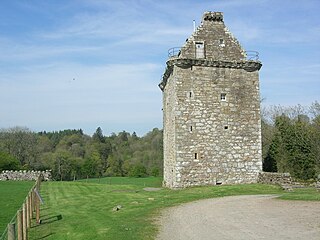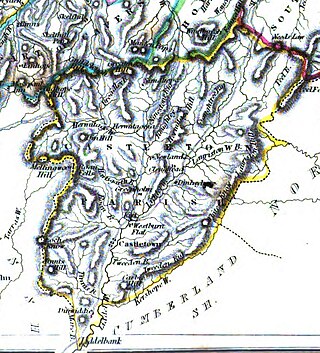Related Research Articles

The Scottish Borders is one of 32 council areas of Scotland. It is bordered by West Lothian, Edinburgh, Midlothian, and East Lothian to the north, the North Sea to the east, Dumfries and Galloway to the south-west, South Lanarkshire to the west, and the English ceremonial counties of Cumbria and Northumberland to the south. The largest settlement is Galashiels, and the administrative centre is Newtown St Boswells.

Jedburgh is a town and former royal burgh in the Scottish Borders and the traditional county town of the historic county of Roxburghshire, the name of which was randomly chosen for Operation Jedburgh in support of the D-Day invasion.

Dryburgh Abbey, near Dryburgh on the banks of the River Tweed in the Scottish Borders, was nominally founded on 10 November (Martinmas) 1150 in an agreement between Hugh de Morville, Constable of Scotland, and the Premonstratensian canons regular from Alnwick Abbey in Northumberland. The arrival of the canons along with their first abbot, Roger, took place on 13 December 1152.
William Turnbull was a Scottish politician and bishop, credited with founding Jedburgh Grammar School and the University of Glasgow. He served as the Bishop of Glasgow, from 1448 to 1454 and was the first Chancellor of the University of Glasgow.

The Archdiocese of Glasgow was one of the thirteen dioceses of the Scottish church. It was the second largest diocese in the Kingdom of Scotland, including Clydesdale, Teviotdale, parts of Tweeddale, Liddesdale, Annandale, Nithsdale, Cunninghame, Kyle, and Strathgryfe, as well as Lennox, Carrick and the part of Galloway known as Desnes.
William Kerr, 3rd Marquess of Lothian, was a Scottish nobleman, styled Master of Jedburgh from 1692 to 1703 and Lord Jedburgh from 1703 to 1722.

Jedburgh Abbey, a ruined Augustinian abbey which was founded in the 12th century, is situated in the town of Jedburgh, in the Scottish Borders 10 miles (16 km) north of the border with England at Carter Bar.

Gilnockie Tower is a 16th-century tower house, located at the hamlet of Hollows, 2.3 km north of Canonbie, in Dumfriesshire, south-west Scotland. The tower is situated on the west bank of the River Esk. It was originally known as Hollows Tower.

The Jed Water is a river and a tributary of the River Teviot in the Borders region of Scotland.

The Prior, then Abbot and then Commendator of Dunfermline was the head of the Benedictine monastic community of Dunfermline Abbey, Fife, Scotland. The abbey itself was founded in 1128 by King David I of Scotland, but was of earlier origin. King Máel Coluim mac Donnchada had founded a church there with the help of Benedictines from Canterbury. Monks had been sent there in the reign of Étgar mac Maíl Choluim and Anselm had sent a letter requesting that Étgar's brother and successor King Alaxandair mac Maíl Coluim protect these monks. By 1120, when Alaxandair sent a delegation to Canterbury to secure Eadmer for the bishopric of St Andrews, there is a Prior of the Dunfermline monks by the name of Peter leading the delegation. Control of the abbey was secularized in the 16th century and after the accession of James Stewart in 1500, the abbey was held by commendators. In the second half of the 16th century, the abbey's lands were being carved up into lordships and it was finally annexed to the crown in July, 1593.
The Prior of Restenneth was the head of the Augustinian canons of Restenneth Priory, Angus. The following is a list of priors and commendators:

Restenneth Priory was a monastic house of Augustinian canons founded by Jedburgh Abbey, with the patronage of King Malcolm IV of Scotland, in 1153. Although there is little literary evidence, archaeological evidence strongly indicates that there was a monastery at Restenneth from very early times. There is also speculation that Restenneth may even have been the Pictish church dedicated to St Peter built in 710 for Nechtán mac Der Ilei, King of the Picts.
The Prior of Canonbie was the head of the Augustinian monastic community of Canonbie Priory, in Dumfries and Galloway. The priors are badly documented and few are known. The following is a list of priors who are known:

Arbirlot is a village in a rural parish of the same name in Angus, Scotland. The current name is usually presumed to be a contraction of Aberelliot or Aber-Eliot - both meaning the mouth of the Elliot. It is situated west of Arbroath. The main village settlement is on the Elliot Water, 2+1⁄2 miles (4 km) from Arbroath. There is a Church of Scotland church and a primary school. The school lies 1 mile (1.6 km) further west, in the approximate geographic centre of the parish.
The Abbot of Jedburgh was the head of the Augustinian canons of Jedburgh Abbey, Roxburghshire. It was founded by King David I of Scotland in 1138, and David's grandson and successor Máel Coluim IV ensured its promotion to the status of abbey before 1156. The position was secularized in the 16th century, and in 1606 turned into a secular lordship for the last commendator, Alexander Home, now earl of Home.

Castleton is a civil parish in the Scottish Borders area of Scotland, in the former Roxburghshire, in the extreme south of the Borders area. It is bounded by Northumberland (England), Dumfries and Galloway, and the parishes of Hobkirk, Southdean and Teviothead. The village of Castleton was commenced in 1793. It was built as a result of the land clearances in the 1790s when people were forced to move from Old Castleton village. While the parish retained the name Castleton, the village later became identified as New Castleton or Newcastleton. The parish is also known by its older name Liddesdale

Jedburgh Grammar School is a state secondary school in Jedburgh, Scotland, with around 440 pupils, 40 teaching staff, and 15 non-teaching staff.

Jedburgh Library is now housed in the second building built for Andrew Carnegie in Jedburgh at a cost of £1,700. It was one of the many libraries built by Carnegie. There have been subscription libraries in the town since at least 1780 and at one time there were three or four. This library has been open since the start of the 20th century but plans in 2020 were revealed to close it.
References
- Cowan, Ian B. & Easson, David E., Medieval Religious Houses: Scotland With an Appendix on the Houses in the Isle of Man, Second Edition, (London, 1976), p. 90
- Watt, D.E.R. & Shead, N.F. (eds.), The Heads of Religious Houses in Scotland from the 12th to the 16th Centuries, The Scottish Records Society, New Series, Volume 24, (Edinburgh, 2001), pp. 28–9